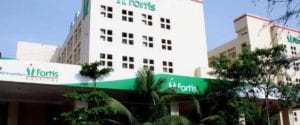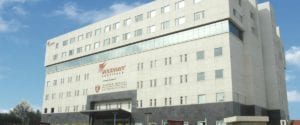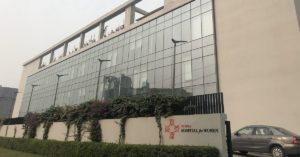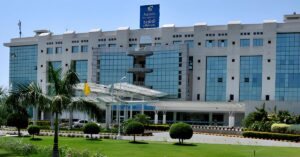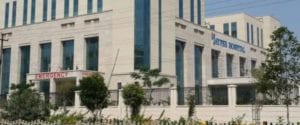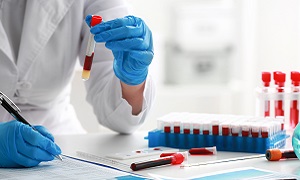Best Doctors in India for Endovascular Aneurysm Repair (EVAR) Treatment
Best Hospitals in India for Endovascular Aneurysm Repair (EVAR) Treatment
- City: Mumbai, India
Hospital Highlights:
- Fortis Hiranandani hospital was established in 2007.
- The hospital is an advanced tertiary care, multi-specialty hospital equipped with 149 beds.
- The hospital is equipped with a super ICU to provide emergency medical care to critically ill patients.
- The hospital is NABH accredited.
- The critical care facility in the hospital is augmented with the state-of-the-art facilities that facilitate speedier diagnosis and efficient monitoring.
- The hospital provides specialty medical services in cardiology, orthopedic science, pediatric science, neurology, diabetic care, urology, nephrology, ENT, obstetrics, gynecology, cosmetic surgery, bariatric surgery, neuro and spine care.
- City: Gurugram, India
Hospital Highlights:
- W Pratiksha Hospital, Gurugram, is one of the best hospitals in the NCR region. It is also a top hospital in India for IVF. Since its inception, the hospital has performed over 5500 successful IVFs. The hospital also specializes in gynecology.
- With over 20 years of experience in providing quality healthcare, the hospital is known as one of the most trusted and valued health providers in India.
- Equipped with world-class medical facilities and advanced technology, the hospital’s doctors and clinicians also have a track record of delivering excellent results. The hospital is also known for focusing on preventive well-being as much as on curative treatment.
- The hospital has earned the trust of its patients, by providing the best available treatments at affordable costs.
- City: Gurugram, India
Hospital Highlights:
- Paras hospital was established in 2006 and is the 250 bedded flagship hospital of Paras Healthcare.
- The is supported by a team of doctors of international and national repute.
- The hospital is NABH accredited and also the first hospital in the region to have a NABL accredited laboratory.
- The hospital provides specialty medical services in around 55 departments including Neurosciences, Joint Replacement, Mother & Child Care, Minimal Invasive Surgery, Gynecology and Obstetrics, Ophthalmology, Dermatology, Endocrinology, Rheumatology, Cosmetic and Plastic surgery.
- The hospital is equipped with state-of-the-art technologies.
- City: Kolkata, India
Hospital Highlights:
- Fortis Hospital, Anandapur, Kolkata is a world-class super-speciality equipped with the latest technologies in the medical world.
- The hospital is NABH accredited.
- This state-of-the-art facility specializes in cardiology and cardiac surgery, urology, nephrology, neurosciences, orthopaedics, digestive care, emergency care and critical care.
- The hospital, governed by integrated Building Management System (IBMS), has a pneumatic chute system, for quick vertical and horizontal transportation between floors, facilitating speedy transfer of patient specimens, documents, reports, and medicines to the concerned departments.
- The hospital also has a nephrology department with over 28 advanced dialysis units.
- City: Mumbai, India
Hospital Highlights:
- SL Raheja hospital is a 140-bed multi-specialty tertiary care hospital that is being managed by Fortis Healthcare Ltd.
- The hospital is a benchmark in healthcare and medical facilities in the neighborhood of Mahim & the western suburbs.
- L.Raheja Hospital, Mahim has one of the most effective ICU and Casualty care services.
- The hospital provides specialty medical services in Cardiology, Oncology, Neurology, Orthopedics, Mother & Child Care, and in Diabetes.
- City: Mumbai, India
Hospital Highlights:
- Wockhardt Hospitals were established in the year 1973, originally called First Hospitals and Heart Institute.
- Wockhardt Hospitals are super specialty health care networks in India, nurtured by Wockhardt Ltd, India’s 5th largest Pharmaceutical and Healthcare company.
- Wockhardt Hospitals is associated with Partners Harvard Medical International, an international arm of Harvard Medical School, USA.
- Wockhardt Heart Hospital performed India’s first endoscopic heart surgery.
- The hospital has a state-of-the-art infrastructure equipped with the latest technologies and modern equipment.
- It has special Centers of Excellence dedicated to the major specialties to provide hassle-free and high-quality clinical care.
- City: Gurugram, India
Hospital Highlights:
- The CK Birla Hospital in Gurugram is a NABH-accredited multi-specialty hospital.
- The hospital strives to increase the quality of healthcare by focusing on UK NHS nurse and midwife training requirements. Policies and practices derived from the National Institute for Health and Treatment Excellence (NICE) recommendations in the United Kingdom ensuring that a strong focus on safety, high-quality clinical care, and sanitation is maintained.
- The hospital’s cutting-edge technology and facilities allow for real-time communication and seamless collaboration among caregivers, ensuring accuracy and the best possible results. Those with foreign experience and accreditations make up part of the hospital’s team of clinicians.
- City: Ahmedabad
Hospital Highlights:
- As a member of the Apollo Hospitals Group, Apollo Hospitals International Limited, Ahmedabad is one of the most popular and sought-after medical facilities in Gujarat.
- Through its 6 Centres of Excellence and various affiliated branches, which cover all specialties and subspecialties, the hospital provides the most advanced clinical services.
- Since its inception in 2003, the hospital has been providing each patient with the most up-to-date medical equipment and state-of-the-art technology.
- With more than 150 successful organ transplants, including liver and renal transplants, the facility has been able to build a strong and extensive organ transplant program.
- In addition to performing 600 surgeries and caring for over 1800 patients on an IP basis, the hospital sees more than 18,000 patients on average in the outpatient department.
- With one of the biggest cardiology teams in the area, the hospital provides state-of-the-art regional care treatment in Cardiac Sciences.
- Additionally, the hospital offers a broad range of Neuro Interventional techniques to help stroke patients recover more quickly.
- City: Noida, India
Hospital Highlights:
- Jaypee Hospital is the flagship hospital of the Jaypee Group.
- This hospital has commissioned 525 beds in the first phase and has been planned and designed as a 1200 bedded multi-specialty facility.
- It holds the accreditation of the NABH and NABL.
- The hospital has state-of-the-art infrastructure equipped with the latest technologies and modern equipment like 64 Slice PET CT, Dual Head 6 Slice SPECT CT, Gamma Camera, and Da Vinci Robotic Surgery for comprehensive robotic surgical solutions.
- It has special Centers dedicated to the major specialties to provide hassle-free and high-quality clinical care.
- City: Mumbai, India
Hospital Highlights:
- Reliance Hospital is one of the best super-specialty care hospitals in Navi Mumbai.
- The main purpose of this hospital is to become a trustworthy place for the best health and hope for society. The hospital is well connected to the suburbs of Mumbai and Navi Mumbai.
- The hospital has various specialty departments, viz., Accident & Emergency, Anesthesiology, Dental Services, Dermatology, Diabetology, Dietetics Nutrition, Endocrinology, ENT, Gastroenterology, General Surgery, Gynaecology And Obstetrics, Hepato Pancreato Biliary Surgery, Infectious Disease, Internal Medicine, Interventional Radiology, Laboratory Medicine, Minimal Access Laparoscopic Surgery, Nephrology, Neurosciences, Opthalmology, Orthopaedics, Paediatrics, Pain Management Palliative Care, Physical Medicine Rehabilitation, Plastic And Reconstructive Surgery, Psychiatry, Pulmonary Medicine, Radiology, Rheumatology, Transplant, Urology Andrology, Vascular Surgery
Endovascular Aneurysm Repair (EVAR)
Endovascular aneurysm repair or EVAR is a procedure for treating an aneurysm or abnormal enlargement of the abdominal aorta. When the abdominal aorta gets enlarged, there are generally two ways to perform surgery. It might be performed through an open incision or in a minimally-invasive procedure known as endovascular aneurysm repair.
This technique has an advantage, which is that there is no abdominal surgery. This makes this technique safer than the traditional open surgery and you also need to spend lesser time at a hospital.
Purpose
The largest artery in your body is the aorta. It helps to transport blood from your heart to various other body parts. When the aorta runs through the chest, it is known as thoracic aorta and when it reaches the abdomen, it is called as the abdominal aorta. This aorta helps supply blood to the lower parts of your body. The normal diameter of this aorta is around 1 inch or 2 cm. However, when it gets weakened or stretched, then it might expand or bulge. This condition is known as abdominal aortic aneurysm. When this aneurysm is over 5.5 cm, this increases the risk of a rupture and your doctor might consider a surgery.
Preparation
First your doctor will explain you how the procedure is done and you will have the opportunity to ask any questions that you might have. Your doctor might need to examine your medical history to ensure that you are in good health. You might also need to undergo blood tests as well as other diagnostic tests.
You will be asked to fast for a minimum of eight hours before your procedure, generally after midnight.
You should notify your doctor if you are pregnant, or if you think you might be. You should also let your doctor know about any medications that you are taking.
If you have a history of bleeding disorders, or if you are having anticoagulant medications, then it might be necessary for you to stop taking these medications. If you smoke, you will need to stop it as soon you can before the procedure. Smoking can interfere with your chances of having a successful recovery from the surgery and to improve your overall health status.
The areas of your surgical site might require shaving before the procedure.
Procedure
Procedures might vary depending on your condition, as well as on the skills and experience of your doctor.
First you will need to lie on your back on the procedure table. Then your heart rate will be continuously monitored. Once you are sedated with anesthesia, a breathing tube is likely to be inserted through your lungs. You will be connected to a ventilator, which will help you in breathing throughout the surgery.
Your surgeon will make an incision in each groin, to expose the femoral arteries. Using a method known as fluoroscopy, he will be inserting a needle into the femoral artery through which a guidewire is going to be passed and advanced to the aneurysm site.
Then he/she will inject contrast dye to visualize the position of the aneurysm and its adjacent blood vessels. After this, he/she will use special endovascular instruments and X-ray images for guidance. A stent-graft is then going to be inserted through the femoral artery, and will be advanced up into the aorta to the site of the aneurysm. It will be expanded and attached to the wall of the aorta.
An aortogram is going to be done to check for an endoleak, i.e. blood leaking out into the aneurysm sac of the stent graft. Once it is determined, that there is no leak, the instruments are going to be removed.
Then the incisions are going to be sutured back together, and the doctor will apply a bandage or a dressing.
Recovery
Depending on your condition, you may or may not be sent to the ICU. However, it is likely that you are going to be taken to a post-anesthesia care unit. You are going to be connected to monitors that will be constantly displaying your ECG tracing, blood pressure, breathing rate, your oxygen level as well as other pressure readings.
If you experience any pain, you will receive the appropriate medicines.
Slowly, you will be able to increase your daily activities gradually.
Once you are home, make sure that you keep the surgical site clean and dry. You will receive instructions from your doctor regarding this. If the sutures or surgical staples were not removed before you left the hospital, they will be removed during a follow-up office visit.
You should not drive unless your doctor tells you to.
If you experience fevers or chills, redness, swelling or bleeding at the incision site, or increase in pain around the incision site, then you need to notify your doctor soon.
Risks
There is a small risk that you might experience any of the following after the surgery:
- Heart attack
- Kidney failure
- Chest problem
- Stroke
- Loss of circulation in your legs or bowel
- Infection in the graft which was used to replace your aorta
A small percentage of men might also have difficulty in sustaining an erection after the surgery. If you experience you should inform your doctor, as there are treatments that are able to help.
Another recognized risk is deep vein thrombosis, which most patients can experience during the stay at the hospital. Your surgeon can recommend a treatment to prevent this.
It is best to discuss all risks and possible complications with your surgeon, before you undergo the surgery.

